

There is water in the river As a result- For a short period of time, poly tends to look gray. I recommend letting the heavy coat dry overnight before making a decision whether or not you like it. However, I was completely satisfied after the second coat, so I had no plans to apply a third. Two coats of water were applied to the surface This polyurethane based matte is made from In order to create the second wet coat, I sprayed the first light coat then I sanded gently at 320 grit, wiped with the microfiber towel and re-applied the second light I didn't see any marks, fish eyes, or anything like that on the level. Afterwards, we wipe the wood grain with a dry towel to remove all of the fine particles.

As soon as the towel is damp, it will turn black, but as soon as the finish is dry, it is easily cleaned. You can then wipe the entire surface with a barely damp microfiber towel, followed by a super dry microfiber towel, after buffing the entire surface with the same 3M pad.

In a few minutes, the 3M pad will lightly blend the new area in with the existing one (after it has dried completely). During a worst case scenario, if you start seeing the wood through the ink, you can reapply some ink to that area and just wipe it until it hazes over so you can see the wood through the ink. Whenever you see blotchy areas I recommend using a gray 3M pad and "sanding" them with the grain until they disappear. The shellac effect is what comes to mind. Performing only one task at a time is crucial It flashes so fast that it can only display 2sf at a time. When you see reflected light on the surface, you would be able to see it. Allowing the ink to pool or to dry in thicker layers will cause it to Under a polyurethane topcoat such as urethane, these blotches may still be visible. To produce uniform thicknesses in the layer(s), we will need to determine a uniform thickness. The key to applying this product to wood is to keep wiping it until it begins to haze. Additionally, anything that comes into contact with the ink will stain it. If you don't have gloves on, don't even think about opening the bottle. I wonder who the Amazon genius was who came up with “sheerness” as Are you serious? In any case, I used this ultra black India ink to make a black dining table made from red oak. Countertops, however, I believe, are best suited for making bar tops. Regardless of how materially strong this product (physically) is, I believe it will not make a good bar top. The answer I can give you is not a good one if this was the question you meant to ask. Wood, stone, and laminate, as well as whether it was sealed or not. My misunderstanding of your question may be misunderstanding my curiosity, but it seems as if you were wondering if you might be thinking of using this to dye/color Bar tops can be successfully made out of different materials, and their success is dependent on that material. While I understand the possibility of precariously balancing a shot glass on top of this bottle, I feel that this task would become increasingly challenging after one shot of liquor has been consumed. It's just too small to use for a countertop, even on a small bar, based on the dimensions and shape of the container. Not the bottle, but the dye was our reason for purchasing this product. It looks like it would make a great bar counter top, can it?


 0 kommentar(er)
0 kommentar(er)
